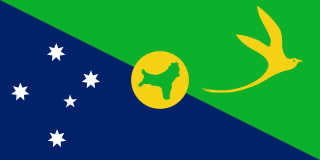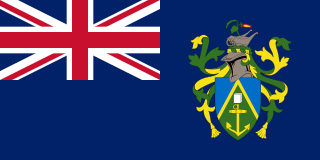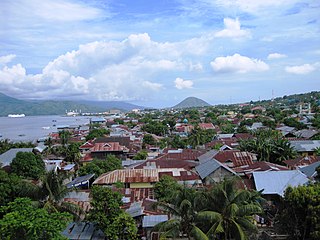
The Cayman Islands is an autonomous British Overseas Territory in the western Caribbean Sea. The 264-square-kilometre (102-square-mile) territory comprises the three islands of Grand Cayman, Cayman Brac and Little Cayman, which are located to the south of Cuba and northeast of Honduras, between Jamaica and the Yucatán Peninsula. As of July 2018, the total population of the Cayman Islands is estimated to be 59,613, making it the second-most populated British overseas territory after Bermuda. The capital city is George Town, situated on Grand Cayman, by far the most populous of the three islands.

The Territory of Christmas Island is an Australian external territory comprising the island of the same name. Christmas Island is located in the Indian Ocean, around 350 kilometres (220 mi) south of Java and Sumatra and around 1,550 kilometres (960 mi) north-west of the closest point on the Australian mainland. It has an area of 135 square kilometres (52 sq mi).

The Canary Islands is a Spanish archipelago and the southernmost autonomous community of Spain located in the Atlantic Ocean, 100 kilometres west of Morocco at the closest point. The Canary Islands, which are also known informally as the Canaries, are among the outermost regions (OMR) of the European Union proper. It is also one of the eight regions with special consideration of historical nationality recognized as such by the Spanish Government. The Canary Islands belong to the African Plate like the Spanish cities of Ceuta and Melilla, the two on the African mainland.

The Marshall Islands, officially the Republic of the Marshall Islands, is an island country and a United States associated state near the equator in the Pacific Ocean, slightly west of the International Date Line. Geographically, the country is part of the larger island group of Micronesia. The country's population of 53,158 people is spread out over 29 coral atolls, comprising 1,156 individual islands and islets.

The Pitcairn Islands, officially Pitcairn, Henderson, Ducie and Oeno Islands, are a group of four volcanic islands in the southern Pacific Ocean that form the sole British Overseas Territory in the South Pacific. The four islands – Pitcairn proper, Henderson, Ducie, and Oeno – are scattered across several hundred miles of ocean and have a combined land area of about 47 square kilometres (18 sq mi). Henderson Island accounts for 86% of the land area, but only Pitcairn Island is inhabited. The nearest places are Mangareva to the west and Easter Island to the east.

Solomon Islands is a sovereign state consisting of six major islands and over 900 smaller islands in Oceania lying to the east of Papua New Guinea and northwest of Vanuatu and covering a land area of 28,400 square kilometres (11,000 sq mi). The country's capital, Honiara, is located on the island of Guadalcanal. The country takes its name from the Solomon Islands archipelago, which is a collection of Melanesian islands that also includes the North Solomon Islands, but excludes outlying islands, such as Rennell and Bellona, and the Santa Cruz Islands.

A presidio is a fortified base established by the Spanish in areas under their control or influence.
The term is derived from the Latin word praesidium meaning protection or defense.
Gómez Pérez Dasmariñas y Ribadeneira was a Spanish politician, diplomat, military officer and colonial official. He was the seventh governor-general of the Philippines from May or June 1, 1590 to October 25, 1593. The city of Dasmariñas, located 24 km south of Manila, was named after him. Dasmariñas was a member of the Order of Santiago.
Pedro de Rojas was a Spanish licenciado (lawyer) and colonial official in the Philippines and New Spain. For 40 days in 1593 he served as interim governor of the Philippines.
Luis Pérez Dasmariñas y Páez de Sotomayor was a Spanish soldier and governor of the Philippines from December 3, 1593 to July 14, 1596. In 1596 he sent unsuccessful expeditions to conquer Cambodia and Mindanao.
Francisco de Tello de Guzmán was Spanish governor of the Philippines from July 14, 1596 to May 1602. He was a knight of the Order of Santiago.
Pedro Bravo de Acuña was a Spanish military officer and colonial official in the New World and the Philippines. From 1602 to 1606 he was governor of the Philippines.
Fernándo de Silva was a Spanish diplomat and colonial official. From July 1625 to June 28, 1626 he was interim governor of the Philippines.
Juan Cerezo de Salamanca was interim Spanish governor of the Philippines from August 2, 1633 to June 25, 1635.
The Free Company of Volunteers of Catalonia was a military company of the Spanish Army serving in the Spanish colonial empire.

Terrenate is a city, and the surrounding municipality of the same name, in the Mexican state of Tlaxcala.
It is situated in the highest part of the state, at 2,680 metres above sea level. "Terrenate" is a Nahuatl name meaning "land the colour of masa".

The Faroe Islands, or the Faeroe Islands—a North Atlantic archipelago located 200 miles (320 km) north-northwest of the United Kingdom and about halfway between Norway and Iceland—are an autonomous country of the Kingdom of Denmark. Total area is about 1,400 square kilometres (540 sq mi) with a population of 50,322 in October 2017.

The First Battle of Terrenate on July 7, 1776 was a military engagement during the Spanish period of Arizona. It was fought between Spanish soldiers and Apache warriors, near the Presidio Santa Cruz de Terrenate in the present day southern Arizona.
The Second Magdalena massacre was an attack by Apaches against the Spanish mission village of Magdalena de Kino, in the present day northern Mexico. The attack occurred sometime in mid November 1776, most or all of Magdalena de Kino's inhabitants were killed so an exact date will never be known.












